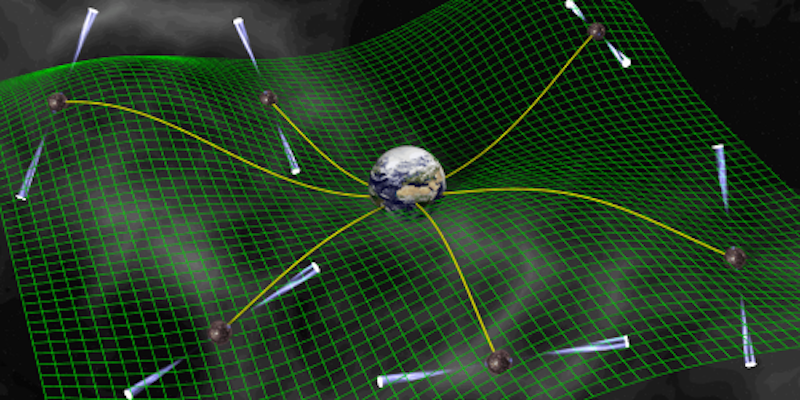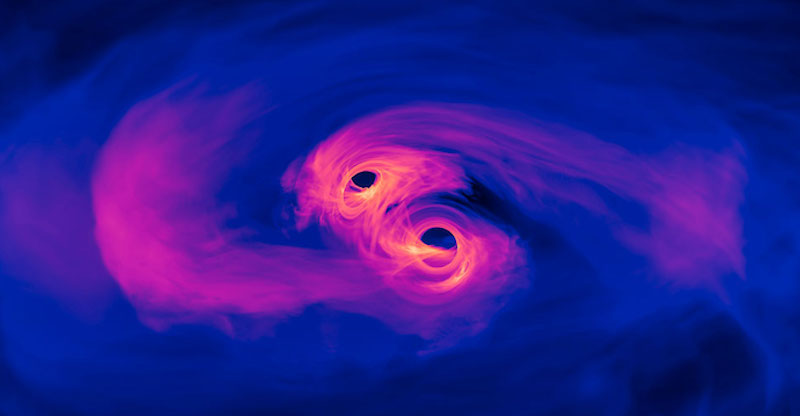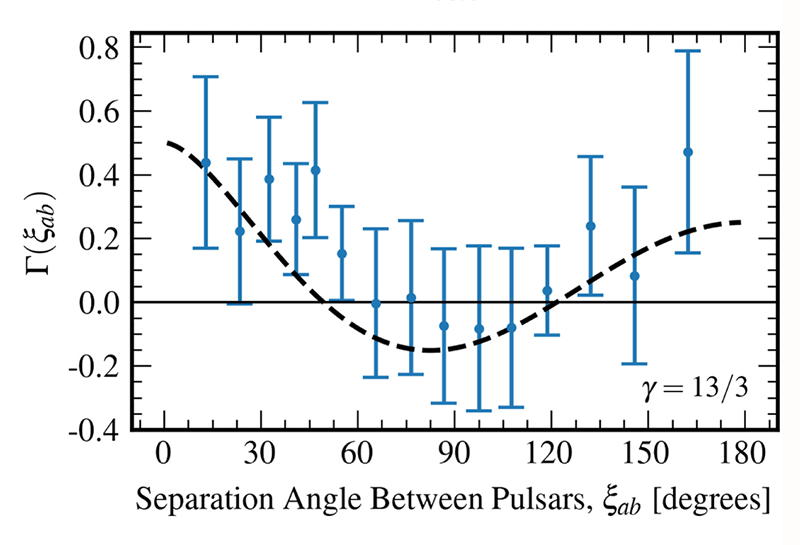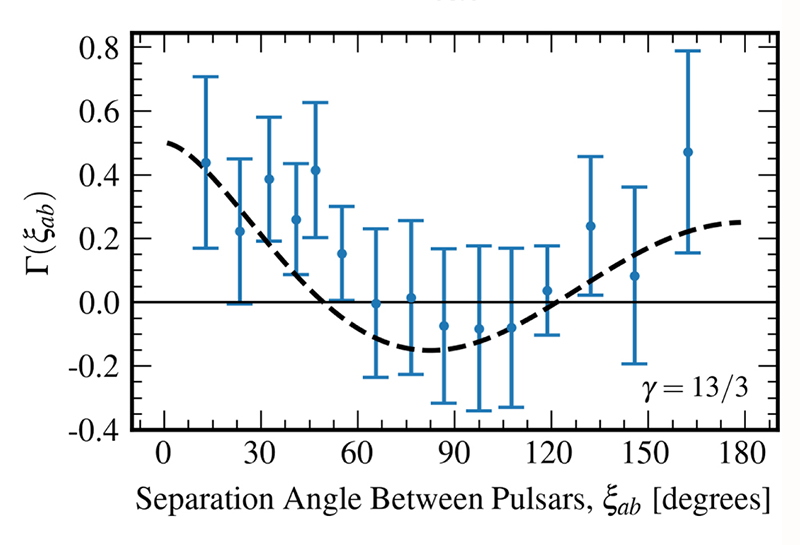Researchers Capture Gravitational-Wave Background with Pulsar “Antennae”
Our Galaxy sails in an ocean of gravitational waves that stretch and compress spacetime on timescales ranging from years to decades. This conclusion has been obtained by several “pulsar timing arrays” (PTAs), experiments that turn the Milky Way into a giant antenna for detecting gravitational waves at nanohertz frequencies. Four independent collaborations—the North American Nanohertz Observatory for Gravitational Waves (NANOGrav), a joint European–Indian effort (EPTA/InPTA), the Chinese PTA, and the Parkes PTA in Australia—have each released a suite of papers that present evidence for this gravitational-wave background [1–4].
The observation opens a window on the sources that could create this background. Researchers concur that a natural explanation involves pairs of supermassive black holes (SMBHs), cosmic mammoths lying at the core of most galaxies. When two galaxies merge, the SMBHs at the center of each galaxy could form a binary, orbiting around each other for thousands or millions of years before merging. The movement of these supermassive bodies would generate gravitational waves at nanohertz frequencies. But source candidates also include inflation and other processes in the early Universe, as well as new physics associated with dark matter. Current data, however, cannot yet discriminate any of these scenarios with a high degree of confidence.
Pulsars are rapidly spinning neutron stars that send out radio-frequency beams from their magnetic poles. As the beams sweep over Earth, they are detected by radio telescopes as blinking signals with a regular “ticking” that rivals the accuracy of atomic clocks. This regularity is key to gravitational-wave detection. If a gravitational wave passes between a pulsar and Earth, the induced spacetime distortion would slightly speed up or slow down the detected tick. The signal from one pulsar, however, could be affected by pulsar fluctuations or by interactions of the beam with the interstellar medium. To make reliable observations, astronomers combine signals from tens of pulsars in the Milky Way—a PTA.
Using radio telescopes in Australia, North America, Europe, India, and China, PTAs have accumulated data over time spans that range from EPTA’s 25 years to CPTA’s 41 months. Expectations rose when three collaborations—NanoGRAV in 2020, followed by PPT and EPTA in 2021—reported signatures consistent with a gravitational-wave background. Namely, they saw that the noise in PTA data wasn’t “white”—that is, with equal intensity at all frequencies—but “red”—it got stronger at lower frequencies. This red hum is expected for signals produced by gravitational waves with oscillation periods in the range of decades.
Assigning the observation to gravitational waves, however, required stronger evidence. In particular, the fluctuations of different pulsars should display an angle-dependent correlation. Signals from pulsars that are close to each other in the sky should be similarly affected by the passage of gravitational waves—and thus be more correlated than signals from angularly separated pulsars. This expected angular correlation is described by the Hellings-Downs curve, named after the researchers who proposed it in 1983.
The PTA collaborations have now delivered that piece of evidence, showing angular correlation data falling on the Hellings-Downs curve. “That’s the telltale signature of the gravitational-wave background,” says Michele Vallisneri, a theoretical physicist with NASA’s Jet Propulsion Laboratory in California and member of NANOGrav. Using various methods, each collaboration estimated the statistical confidence of a gravitational-wave interpretation, with NANOGrav, EPTA/InPTA, and CPTA claiming values ranging between 3 and 4.6 sigma. These values quantify the possibility that the observed signal is not real (3 and 4.6 sigma correspond to a false-alarm probability of less than one in a thousand and less than two in a million, respectively).
The researchers call confidence levels above 3 sigma “evidence” rather than a “detection.” “We will claim a detection once we reach the gold standard of 5 sigma,” Vallisneri says. Yet “the cross validation of the result by four different experiments, using different telescopes and analysis methods, makes this evidence very significant,” adds Alberto Sesana, a physicist at Milano-Bicocca University in Italy and member of EPTA. What’s more—within the framework of the International Pulsar Timing Array, a consortium comprising the five PTA collaborations—the researchers will perform a joint analysis of all data so far collected, Sesana says. “It’s quite possible that this analysis, with no new data, will get us to 5 sigma within a year,” he says.
While it’s extremely likely that the PTA signals can be attributed to gravitational waves, pinning down the sources of these waves is a more challenging question. Teams within the collaborations have modeled “new physics” scenarios that involve extensions of the standard model of particle physics. Such scenarios include primordial signals from inflation, dark matter, or cosmic defects known as cosmic walls and strings. Many of the above-mentioned models fit the data equally well. SMBH binaries, however, offer a well-motivated and “natural” explanation, says astrophysicist Maria Charisi of Vanderbilt University in Tennessee, also with NANOGrav. Simulations by Charisi and her collaborators showed that a population of millions of such binaries could accurately reproduce the observations.
If the PTA signals are attributable to SMBH binaries, the implications for astrophysics would be profound, Charisi says. The signals would constrain the binary properties and imply, for instance, that SMBH binaries are more common or more massive than previously thought. She adds that a binary confirmation would solve a long-standing problem over whether SMBHs can merge or not. For two SMBHs to spiral into each other and merge, their orbital energy has to be transferred to something. Stars and gas could provide such a drain, but some researchers questioned whether that drain would be sufficient to bring the SMBHs close enough for a merger. If the nanohertz gravitational-wave background comes from SMBHs, that means these heavyweight objects are in tight orbits and thus inevitably doomed to merge, Charisi says.
With continued improvements, measurements from PTAs may become sufficiently precise to provide conclusive tests. For example, variations in the gravitational-wave amplitude at different positions in the sky will be crucial to discriminate between cosmology and SMBH scenarios—cosmological signals should be isotropic, while binary signals should come from preferred directions. Ultimately, the measurements should become sufficiently sensitive to pick out individual binaries from the background, Charisi says. This ability would open up the tantalizing prospect for multimessenger detections that combine gravitational-wave and electromagnetic observations, an approach similar to that used for the 2017 neutron star merger (see Viewpoint: Neutron Merger Seen and Heard). Unlike the neutron stars and black hole mergers detectable by LIGO, the gravitational-wave signal by a SMBH binary wouldn’t last milliseconds, but thousands of years or longer. “Once we detect an individual binary, we’ll be able to collect an inordinate amount of data,” Charisi says.
“The observation of a stochastic gravitational-wave background is revolutionary,” says Chiara Caprini, a cosmologist at the University of Geneva and CERN. She agrees that, by Occam’s razor, SMBH binaries are the most plausible explanation, but she is thrilled by the possibility of exploring cosmological contributions. “Many processes in the primordial Universe could generate a nanohertz background,” she says. And a gravitational-wave background could allow researchers to peer into a much earlier Universe compared to the cosmic microwave background, which gives a view of the Universe 380,000 years after the big bang. Chad Hanna, an astrophysicist at Pennsylvania State University and member of the LIGO Collaboration, likens the observation of the gravitational background to the detection of the first black hole merger by LIGO and Virgo. “For us, it was the opening of a floodgate.” PTAs have now opened an entirely new regime for probing gravitational waves, he says.
–Matteo Rini
Matteo Rini is the Editor of Physics Magazine.
References
- G. Agazie et al., “The NANOGrav 15 yr data set: Evidence for a gravitational-wave background,” Astrophys. J., Lett. 951, L8 (2023).
- J. Antoniadis et al., “The second data release from the European Pulsar Timing Array III. Search for gravitational wave signals,” arXiv:2306.16214.
- D. J. Reardon et al., “Search for an isotropic gravitational-wave background with the Parkes Pulsar Timing Array,” Astrophys. J., Lett. 951, L6 (2023).
- H. Xu et al., “Searching for the nano-hertz stochastic gravitational wave background with the Chinese Pulsar Timing Array Data Release I,” Res. Astron. Astrophys. 23, 075024 (2023).









